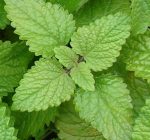 Balm, is a herbaceous perennial and member of the mint family, Labiatae, that also includes basil, rosemary, and ajuga. It is native to the Mediterranean area, North Africa and central Asia but has naturalized throughout much of the world including the US. The 3-4′ tall plant is floppy and has coarse, ovate, toothed leaves that are lemon scented and 1-3″ long. The white to yellow, 2 lipped flowers are 1/2″ long and appear in leaf axils from mid-summer into fall. Balm is hardy in zones 4-9 and is easy to grow in average, well-drained soil in full sun but tolerates some shade. It is easily grown from seed and germinates best in light. The genus name, Melissa, is the Greek word meaning honey bee. The specific epithet, officinalis, is the Medieval Latin word for organisms, mainly plants, used in medicine and herbalism.
Balm, is a herbaceous perennial and member of the mint family, Labiatae, that also includes basil, rosemary, and ajuga. It is native to the Mediterranean area, North Africa and central Asia but has naturalized throughout much of the world including the US. The 3-4′ tall plant is floppy and has coarse, ovate, toothed leaves that are lemon scented and 1-3″ long. The white to yellow, 2 lipped flowers are 1/2″ long and appear in leaf axils from mid-summer into fall. Balm is hardy in zones 4-9 and is easy to grow in average, well-drained soil in full sun but tolerates some shade. It is easily grown from seed and germinates best in light. The genus name, Melissa, is the Greek word meaning honey bee. The specific epithet, officinalis, is the Medieval Latin word for organisms, mainly plants, used in medicine and herbalism.
The history of balm goes back to ancient times. The Roman naturalist, Pliny the Elder, noted that bees liked balm above all other plants and the ancient Greeks planted balm near beehives to encourage the bees to return to the hive. The Greek physician Dioscorides used the plants as a remedy for stings of all kinds, bites of dogs, and to assuage the pain of gout. During the Middle Ages Charlemagne had his monasteries grow lemon balm in their apothecary gardens and the monks used the plant to treat wounds as well as make perfume and liquors. In the 10th century the Arabs are believed to have introduced into Europe the use of lemon balm for lifting the spirits as well as treating a large number health problems such as heart disorders. The uses of balm continued to grow during the Renaissance and Shakespeare mentions its use in the consecration of kings, and as furniture polish and a cure for melancholy.
Early colonists introduced balm to the US and used it to treat a variety of illness but also used it in cooking, cleaning, and to make cosmetics. Several recipes from Old Williamsburg call for the herb and Thomas Jefferson is known for growing it at Monticello. As time has passed, however, the popularity of the balm has waned as other herbs have become better known for their superior results.